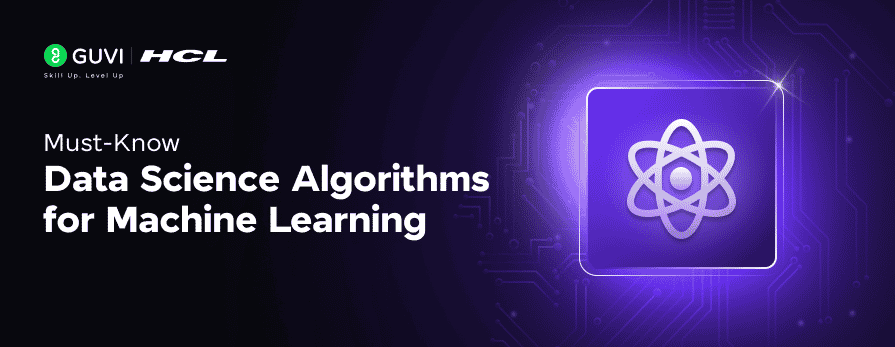
Must-Know Data Science Algorithms for Machine Learning
Oct 08, 2025 4 Min Read 1790 Views
(Last Updated)
Data Science Algorithms play a crucial part in data-driven decision-making. To get high precision and more accurate results, we need to choose the correct data science algorithms and tune them according to the problem requirements. Do you get confused over which algorithms to choose? We got you covered!
In this blog, we’ll explore the different types of data science algorithms, how to choose the right ones for various tasks, and dive into advanced algorithms for more complex problems. It’s designed to be a go-to resource on your data science journey. Let’s get started!
Table of contents
- What is Data Science?
- Types of Data Science Algorithms for Machine Learning
- Supervised Learning
- Unsupervised Learning
- Reinforcement Learning
- Advanced Data Science Algorithms
- Ensemble Methods
- Deep Learning Algorithms
- Evolutionary Algorithms
- Getting Started with HCL Guvi
- Conclusion
- FAQs
- Q1. Do I need coding for data science?
- Q2. Is DSA required for data science?
- Q3. Which language is best for data science?
- Q4. What industries hire data scientists?
- Q5. Is data science a good career for freshers
What is Data Science?
By the name itself, we can say that it is a science about data. Data science is the study of data to extract meaningful information and insights. Data science is used to provide a data-driven solution to real-world problems. It includes maths, statistics, machine learning(ML), and artificial intelligence(AI).
Types of Data Science Algorithms for Machine Learning
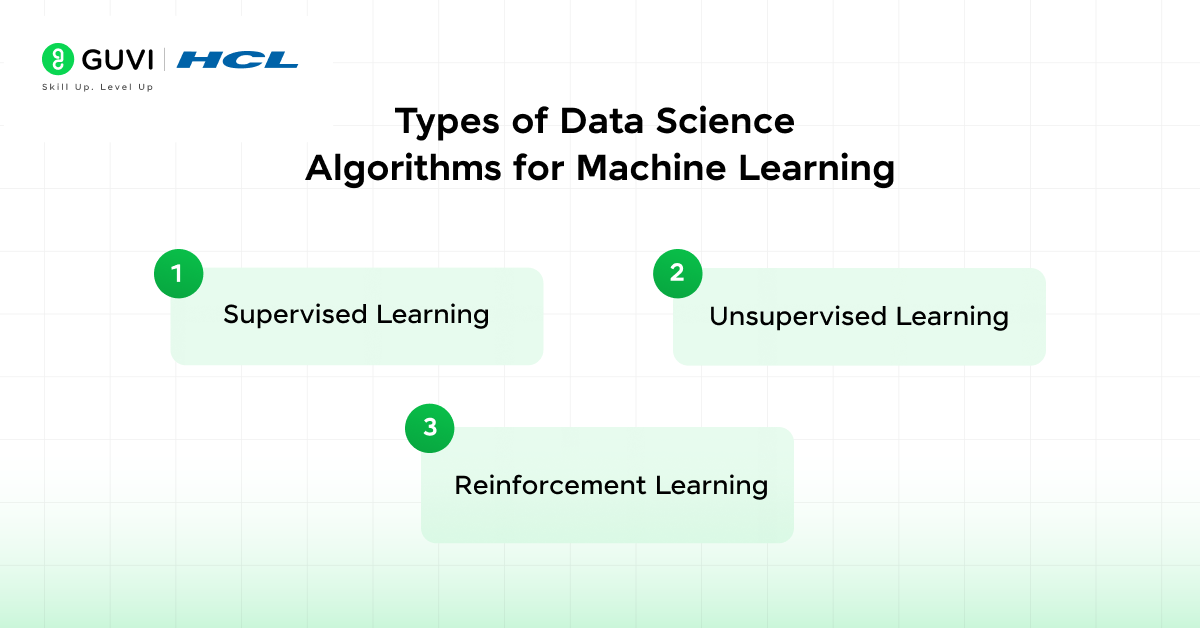
After the data preprocessing step, we need to choose the machine learning or data science algorithms for predicting the outcome. Based on the type of data, the data science algorithms are of three types:
Supervised Learning
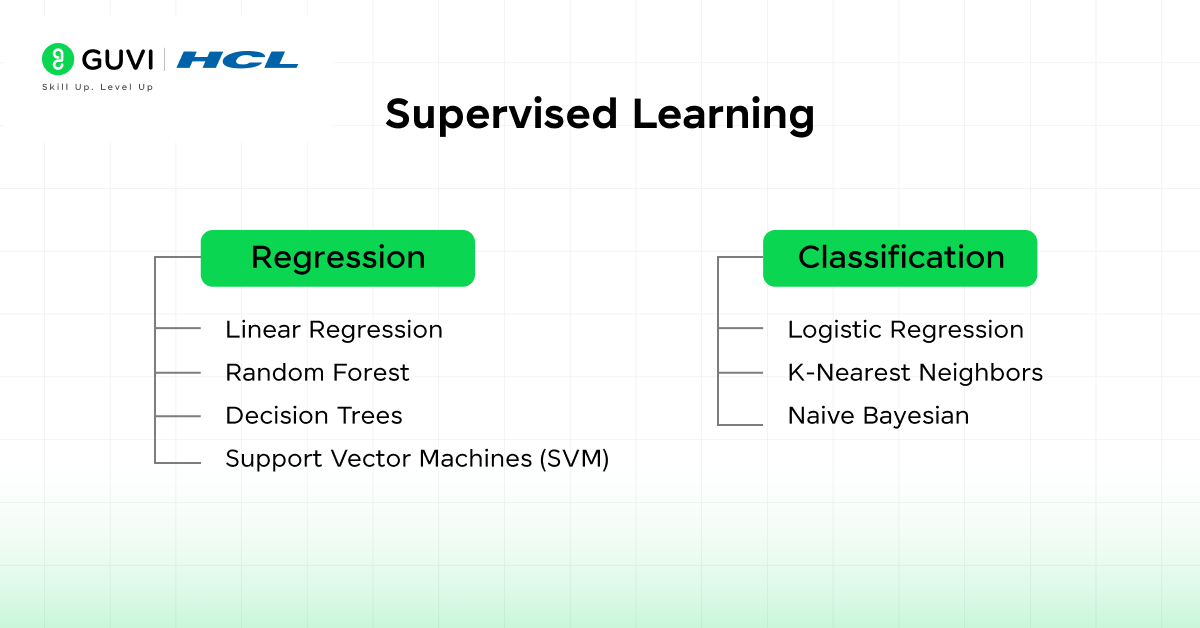
Supervised learning algorithms are trained on a labeled dataset and help predict the results from a labeled dataset. There are two main types in supervised learning: classification and regression. The most widely used supervised learning algorithms are:
Regression
Regression Algorithms are used when the target variable is continuous and numeric. These algorithms model the relationship between the input features and the continuous output variables. Some of the common regression algorithms include:
- Linear Regression
- Random Forest
- Decision Trees
- Support Vector Machines (SVM)
Classification
Classification algorithms are designed to predict the label or categorical outcome for the input variables. It includes tasks such as identifying whether an email is spam or not. These algorithms assign input data into predefined categories based on patterns learned from the training data. Some of the classification algorithms include:
- Logistic Regression
- K-Nearest Neighbors
- Naive Bayesian
Unsupervised Learning
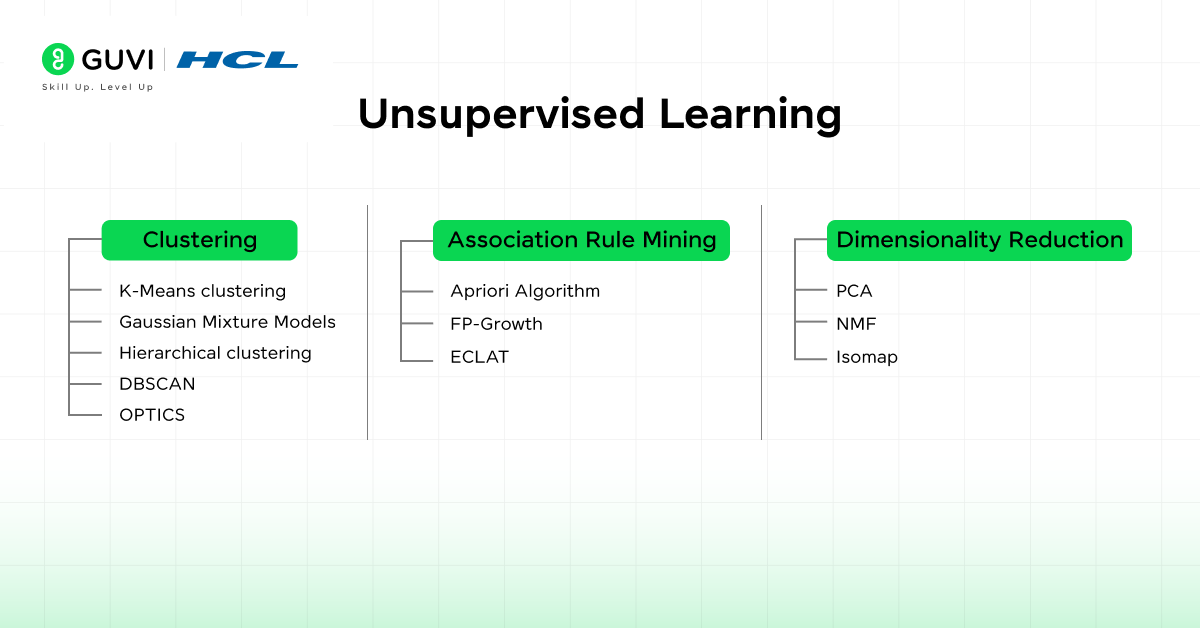
These algorithms are trained on an unlabeled dataset, i.e., by grouping the relevant data. It helps predict the output from unlabeled data. There are three main types of unsupervised learning: clustering, association rule mining, and dimensionality reduction. The most popular unsupervised learning algorithms are:
Clustering
Clustering algorithms are used to group similar data points based on certain patterns without any predefined labels or categories. It helps uncover hidden patterns in data making it easier to analyse and interpret complex datasets. Some of the common clustering algorithms are:
- K-Means clustering
- Gaussian Mixture Models
- Hierarchical clustering
- DBSCAN
- OPTICS
Association Rule Mining
Association rule algorithms are used to discover interesting relationships between variables in a large dataset. These algorithms identify frequent patterns and generate rules based on support, confidence, and lift metrics, which then help businesses make data-driven decisions for recommendation and inventory management. Some of the algorithms include:
- Apriori Algorithm
- FP-Growth
- ECLAT
Dimensionality Reduction
Dimensionality Reduction algorithms are used to reduce the number of input features in a dataset while preserving as much relevant information as possible. It simplifies the complex dataset and makes it easier to understand and work with. Some of the algorithms are:
- PCA
- NMF
- Isomap
Reinforcement Learning
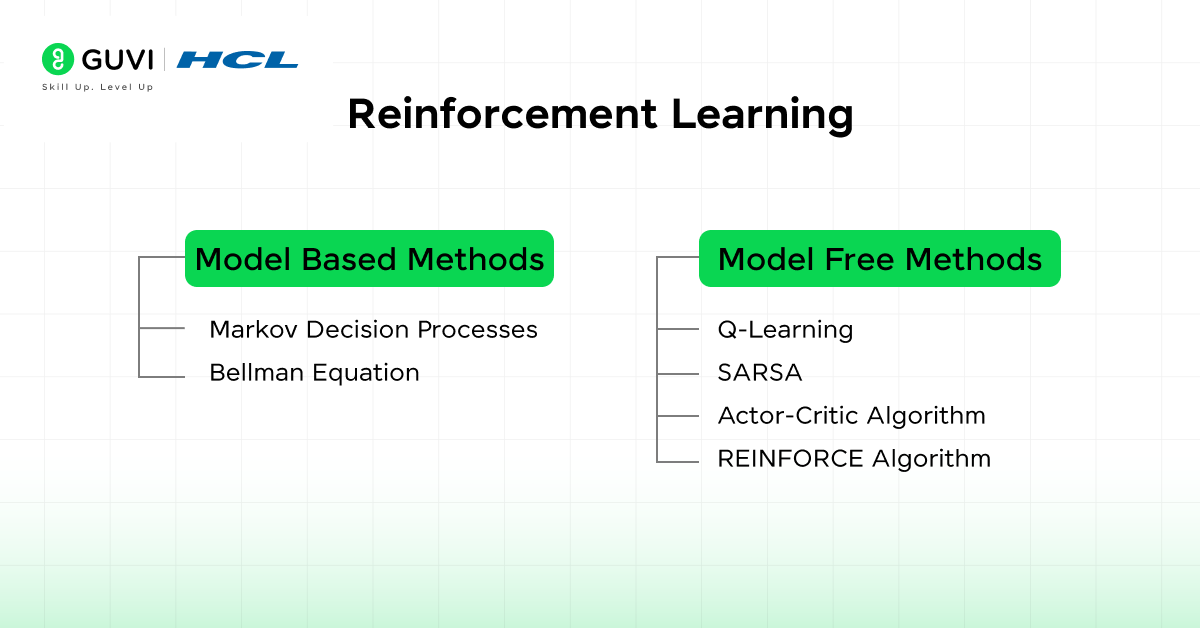
Reinforcement learning is based on a reward mechanism. These algorithms help interact with the environment to get the result. It is broadly classified into model-based and model-free methods. Some of the reinforcement learning algorithms are:
Model-Based Methods
Model-based learning methods involve building a model of the environment to predict future states and rewards. These models are ideal for scenarios where data collection is expensive or slow. Some of the commonly used models based on learning methods are:
- Markov Decision Processes
- Bellman Equation
Model Free Methods
Model-free learning methods do not attempt to learn the environment’s dynamics. It focuses on directly learning the optimal policy or value functions. These methods are widely used in real-world applications such as robotics and game playing. Some of the model-free learning models are:
- Q-Learning
- SARSA
- Actor-Critic Algorithm
- REINFORCE Algorithm
Advanced Data Science Algorithms

This section covers the advanced-level data science algorithms. It goes beyond basic models to handle complex, large-scale scale and real-world problems more effectively and accurately. Let’s look into some of the advanced-level data science algorithms.
Ensemble Methods
Ensemble methods are powerful techniques that combine multiple machine learning models to improve the overall performance of the algorithms. Instead of relying on a single model, ensemble methods aggregate the predictions of several models to reduce variance, bias, or improve accuracy. Some of the ensemble algorithms are:
- Gradient Boosting Machines
- XGBoost
- LightGBM
- CatBoost
- Stacking
Deep Learning Algorithms
Deep learning uses neural networks with many layers to model complex patterns in huge datasets. It is an excellent choice for tasks involving unstructured data such as images, audio, and text. It includes fields like computer vision, speech recognition, and autonomous systems. Some of the popular deep learning algorithms include:
- Convolutional Neural Network (CNN)
- Recurrent Neural Network (RNN)
- Long Short-Term Memory (LSTM)
- Transformer Models
- Autoencoders
- Generative Adversarial Networks (GANs)
Evolutionary Algorithms
Evolutionary algorithms are inspired by natural selection and biological evolution. These optimization techniques work by evolving a population of candidate solutions over several generations to find the best result. The popular evolutionary algorithm is:
- Genetic Algorithms
Getting Started with HCL Guvi
To learn about each data science subject, you do not need to go and look for resources on the internet. We provide you with the best roadmap and a bootcamp course that covers all the necessary data science algorithms with detailed doubt-clearing sessions.
Check out HCL Guvi’s FREE E-book on Master the Art of Data Science – A Complete Guide. It provides a detailed data science roadmap and guide to start your career in data science. This is a great way to start your career.
Incorporating emerging trends into data science will fuel the rapid growth of this field, unlocking countless opportunities for aspiring data scientists. If you’re ready to take advantage of this moment and launch your career, enroll in HCL Guvi’s industry-recognized, certified Data Science course today.
Conclusion
Choosing the right algorithm is a crucial step in solving any data science problem effectively. From understanding the basics to exploring advanced techniques, we’ve walked through a variety of algorithms and their ideal use cases. Remember that mastering these tools takes time, experimentation, and continuous learning. Let this blog be a helpful guide whenever you need a refresher or direction.
FAQs
Q1. Do I need coding for data science?
Yes, coding is an essential skill for data science. Being comfortable with coding is crucial for tasks like data manipulation, building machine learning models, and automating processes. Python and R are the most commonly used programming languages in data science, and they have extensive libraries to make your job easier.
Q2. Is DSA required for data science?
Yes, Data Structures and Algorithms (DSA) is important for data science, especially for machine learning and data engineering. DSA helps with data management, analysis, and problem solving. It can also help you write efficient code. You can expect DSA-based coding challenges during the interview.
Q3. Which language is best for data science?
The most popular and widely used language for data science is Python. It’s beginner-friendly, has a rich ecosystem of libraries (like Pandas, NumPy), and is great for tasks like data cleaning, analysis, and machine learning. For those working on large-scale systems, Scala and Julia are gaining popularity as well, especially for machine learning and high-performance tasks.
Q4. What industries hire data scientists?
Data scientists are in demand everywhere, from tech giants like Google and Amazon to healthcare, finance, retail, and entertainment. Almost every industry is tapping into data to drive smarter decisions.
Q5. Is data science a good career for freshers
Absolutely! With the booming demand for data-driven insights, freshers with strong analytical skills and a passion for learning can easily find opportunities and grow rapidly in the field.



















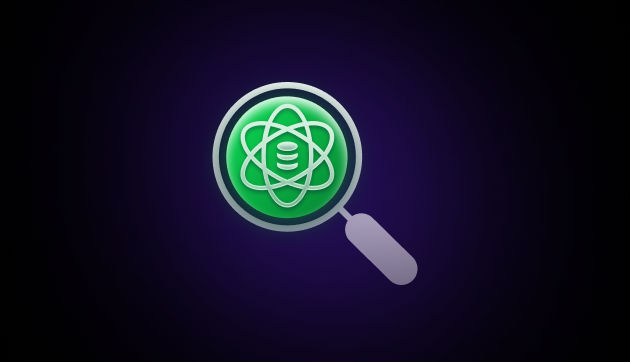


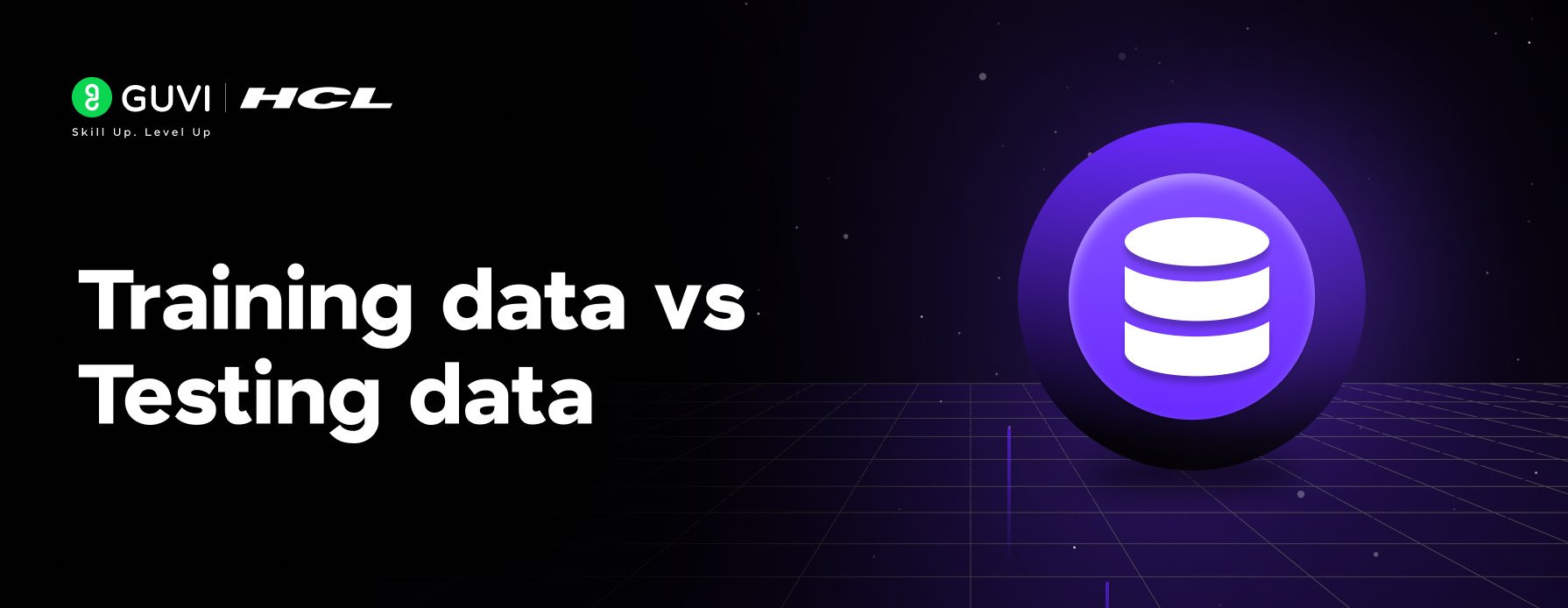






Did you enjoy this article?